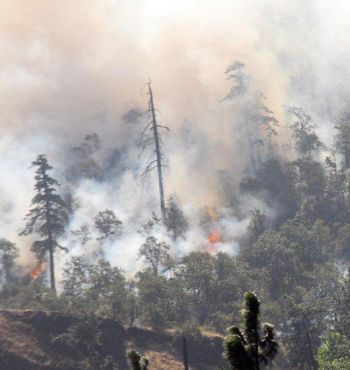
Publisher:
Bonnie King
CONTACT:
Newsroom@Salem-news.com
Advertising:
Adsales@Salem-news.com

~Truth~
~Justice~
~Peace~
TJP
Sep-16-2014 19:10

 TweetFollow @OregonNews
TweetFollow @OregonNews
Wildfire: It's Not If, but When
Salem-News.comYour chances improve when you take prevention measures, and maintain them
 The Rowena Forest Fire next to I-84 was pushed by strong gorge winds within 2 miles of The Dalles western city limits. Photo by Al Hayward (Aug 8, 2014). |
(SALEM, Ore.) - This fire season has shown to be a long and grueling one. Stretching across the state from Klamath Falls to La Grande to Veneta, it started early and seems not to have an end in sight yet.
Defensible space around your home is the critical piece to improve the survivability of your home in the event of a wildfire, and there is still time to create it this fire season.
"Creating defensible space around your home is the best way to make your home more survivable in the wake of a wildfire," says Oregon Department of Forestry's Matt Flock.
"The more you can do to make your home defensible now, will be critical if a wildfire hits your community and you're not home."
When a wildfire starts, there is little to no warning. Defensible space is the way to prepare our homes and property to have a fighting chance in the wildland-urban interface (WUI), said the Community Wildfire Forester.
During a wildfire, firefighters work intensely to prepare homes in the path of a wildfire. The more that landowners can accomplish before the incident happens, the less time firefighters will need to spend preparing the homes and can focus instead on stopping the fire.
"It's the little things you can do that play a key role in keeping your home, family and community safe," he said.
Wildfires that occur in the WUI often are started by human activity and then spread to the forest. Corvallis recently had an 86-acre fire on the north side of town that threatened many homes. For residents, it was a sobering moment of what fire can do and how real it can become to communities near wooded areas.
Once underway a fire follows the fuel, whether it is trees or houses. Creating defensible space around a house is a proven way to make it less vulnerable to wildfire.
The National Firewise Communities Program has great tips for WUI residents to refer to. The program says "Defensible space" simply means to:
- Maintain the landscape around a home to reduce fire danger. - Provide safe access to firefighters so they can protect it.
To create defensible space, Firewise advises to start with the house and work your way out:
CHECK THE ROOF AND RAIN GUTTERS
Leaves and needles in gutters are very susceptible to the ember showers that commonly occur at the head of a raging wildfire. Cleaning that material out from the gutters and off the roof of your home will make it much more difficult for a fire to start there.
REMOVE FUEL SOURCES CLOSE TO THE HOUSE
The perimeter of the home and attachments out to about five feet are vulnerable if organic mulch, arborvitae or other flammable plants are located in that area. A wind-cast ember or a creeping ground fire could ignite fuels in this zone and carry flames to the structure.
MAINTAIN LANDSCAPING IN THE MIDDLE ZONE
Plants in the zone about 30 to 100 feet from the house should be low-growing and well irrigated. Firewise advises to:
- Leave 30 feet between clusters of two to three trees, or 20 feet between individual trees.
- Encourage a mixture of deciduous and coniferous trees.
- Create fuel breaks, such as driveways, gravel walkways and lawns.
- Prune trees up six to 10 feet from the ground.
Pruning trees in this way inhibits a wildfire from climbing into the crowns and carrying flames from tree to tree, and eventually to the house. Doing that allows the fire to stay on the ground where firefighters can fight the fire and keep its spread to a minimum.
OUTER ZONE
The zone 100 to 200 feet from the home requires less attention but still should be looked at for ways to create an outer buffer to wildfire. Trees may need to be thinned, though less intensively than those closer in.
- Remove any heavy accumulations of woody debris.
- Thin out clusters of small trees and remove ladder fuels that can climb into tree canopies.
- Reduce the density of tall trees so canopies are not touching.
HOMEOWNER/FIREFIGHTER ACCESS
Prune trees along the driveway and trim back shrubs so that the egress to leave your home is not blocked by intense fire behavior.
Firefighter will need to use that same road to get into your home as well. Keeping it trimmed and open allows them to do their job and attack the fire as well.
More tips on how to create defensible space around your home and protect it from wildfire can be found at: www.firewise.org.
Source: Oregon Dept. of Forestry
 |
Articles for September 15, 2014 | Articles for September 16, 2014 | Articles for September 17, 2014

Quick Links
DINING
Willamette UniversityGoudy Commons Cafe
Dine on the Queen
Willamette Queen Sternwheeler
MUST SEE SALEM
Oregon Capitol ToursCapitol History Gateway
Willamette River Ride
Willamette Queen Sternwheeler
Historic Home Tours:
Deepwood Museum
The Bush House
Gaiety Hollow Garden
AUCTIONS - APPRAISALS
Auction Masters & AppraisalsCONSTRUCTION SERVICES
Roofing and ContractingSheridan, Ore.
ONLINE SHOPPING
Special Occasion DressesAdvertise with Salem-News
Contact:AdSales@Salem-News.com




Terms of Service | Privacy Policy
All comments and messages are approved by people and self promotional links or unacceptable comments are denied.
[Return to Top]
©2025 Salem-News.com. All opinions expressed in this article are those of the author and do not necessarily reflect those of Salem-News.com.